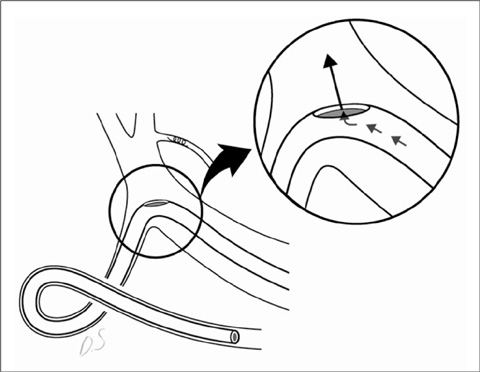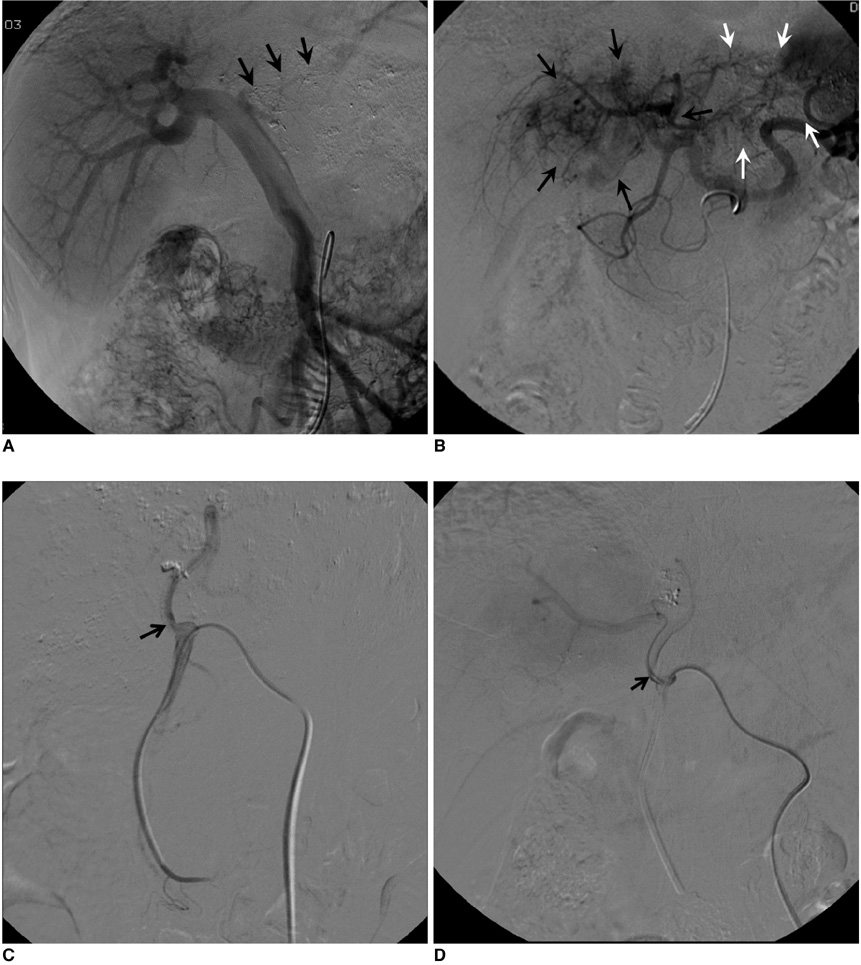Korean J Radiol.
2010 Dec;11(6):648-655. 10.3348/kjr.2010.11.6.648.
A Simplified Technique of Percutaneous Hepatic Artery Port-Catheter Insertion for the Treatment of Advanced Hepatocellular Carcinoma with Portal Vein Invasion
- Affiliations
-
- 1Department of Radiology, Hallym University Sacred Heart Hospital, Gyeonggi-do 431-070, Korea.
- 2Department of Radiology and Research Institute of Radiological Science, Severance Hospital, University of Yonsei, College of Medicine, Seoul 120-752, Korea. doctorlkh@yuhs.ac
- 3Department of Radiology, Inje University Ilsan Paik Hospital, Gyeonggi-do 411-706, Korea.
- 4Department of Radiology, Gangnam Severance Hospital, University of Yonsei, College of Medicine, Seoul 135-720, Korea.
- KMID: 1119228
- DOI: http://doi.org/10.3348/kjr.2010.11.6.648
Abstract
OBJECTIVE
We assessed the outcomes of a simplified technique for the percutaneous placement of a hepatic artery port-catheter system for chemotherapy infusion in advanced hepatocellular carcinoma with portal vein invasion.
MATERIALS AND METHODS
From February 2003 to February 2008, percutaneous hepatic artery port-catheter insertion was performed in 122 patients who had hepatocellular carcinoma with portal vein invasion. The arterial access route was the common femoral artery. The tip of the catheter was wedged into the right gastroepiploic artery without an additional fixation device. A side hole was positioned at the distal common hepatic artery to allow the delivery of chemotherapeutic agents into the hepatic arteries. Coil embolization was performed only to redistribute to the hepatic arteries or to prevent the inadvertent delivery of chemotherapeutic agents into extrahepatic arteries. The port chamber was created at either the supra-inguinal or infra-inguinal region.
RESULTS
Technical success was achieved in all patients. Proper positioning of the side hole was checked before each scheduled chemotherapy session by port angiography. Catheter-related complications occurred in 19 patients (16%). Revision was achieved in 15 of 18 patients (83%).
CONCLUSION
This simplified method demonstrates excellent technical feasibility, an acceptable range of complications, and is hence recommended for the management of advanced hepatocellular carcinoma with portal vein thrombosis.
MeSH Terms
-
Angiography
Antineoplastic Agents/*administration & dosage
Carcinoma, Hepatocellular/*drug therapy/pathology
*Catheters, Indwelling/adverse effects
Embolization, Therapeutic
Female
Femoral Artery/surgery
Fluoroscopy
*Hepatic Artery
Humans
Infusions, Intra-Arterial
Liver Neoplasms/*drug therapy/pathology
Male
Middle Aged
Portal Vein/*pathology
*Radiography, Interventional
Treatment Outcome
Figure
Reference
-
1. Arai Y, Inaba Y, Takeuchi Y, Ariyoshi Y. Intermittent hepatic arterial infusion of high-dose 5FU on a weekly schedule for liver metastases from colorectal cancer. Cancer Chemother Pharmacol. 1997. 40:526–530.2. Sadahiro S, Suzuki T, Ishikawa K, Yasuda S, Tajima T, Makuuchi H, et al. Prophylactic hepatic arterial infusion chemotherapy for the prevention of liver metastasis in patients with colon carcinoma: a randomized control trial. Cancer. 2004. 100:590–597.3. Lorenz M, Müller HH. Randomized, multicenter trial of fluorouracil plus leucovorin administered either via hepatic arterial or intravenous infusion versus fluorodeoxyuridine administered via hepatic arterial infusion in patients with nonresectable liver metastases from colorectal carcinoma. J Clin Oncol. 2000. 18:243–254.4. Allen-Mersh TG, Earlam S, Fordy C, Abrams K, Houghton J. Quality of life and survival with continuous hepatic-artery floxuridine infusion for colorectal liver metastases. Lancet. 1994. 344:1255–1260.5. Arai K, Kitamura M, Iwasaki Y. Extra-arterial dislocation of indwelling catheter in hepatic arterial infusion chemotherapy--special reference to tissue destruction by 5-fluorouracil. Gan To Kagaku Ryoho. 1997. 24:1832–1834. [Japanese].6. Yamagami T, Nakamura T, Yamazaki T, Iida S, Kato T, Nishimura T. Catheter-tip fixation of a percutaneously implanted port-catheter system to prevent dislocation. Eur Radiol. 2002. 12:443–449.7. Wacker FK, Boese-Landgraf J, Wagner A, Albrecht D, Wolf KJ, Fobbe F. Minimally invasive catheter implantation for regional chemotherapy of the liver: a new percutaneous transsubclavian approach. Cardiovasc Intervent Radiol. 1997. 20:128–132.8. Clouse ME, Ahmed R, Ryan RB, Oberfield RA, McCaffrey JA. Complications of long term transbrachial hepatic arterial infusion chemotherapy. AJR Am J Roentgenol. 1977. 129:799–803.9. Oberfield RA, McCaffrey JA, Polio J, Clouse ME, Hamilton T. Prolonged and continuous percutaneous intra-arterial hepatic infusion chemotherapy in advanced metastatic liver adenocarcinoma from colorectal primary. Cancer. 1979. 44:414–423.10. Herrmann KA, Waggershauser T, Sittek H, Reiser MF. Liver intraarterial chemotherapy: use of the femoral artery for percutaneous implantation of catheter-port systems. Radiology. 2000. 215:294–299.11. Strecker EP, Boos IB, Ostheim-Dzerowycz W, Heber R, Vetter SC. Percutaneously implantable catheter-port system: preliminary technical results. Radiology. 1997. 202:574–577.12. Seki H, Kimura M, Yoshimura N, Yamamoto S, Ozaki T, Sakai K. Hepatic arterial infusion chemotherapy using percutaneous catheter placement with an implantable port: assessment of factors affecting patency of the hepatic artery. Clin Radiol. 1999. 54:221–227.13. Seki H, Shiina M. Placement of a long tapered side-hole catheter in the hepatic artery: technical advantages, catheter stability, and arterial patency. AJR Am J Roentgenol. 2006. 187:1312–1320.14. Chuang VP, Wallace S. Hepatic arterial redistribution for intraarterial infusion of hepatic neoplasms. Radiology. 1980. 135:295–299.15. Inaba Y, Arai Y, Matsueda K, Takeuchi Y, Aramaki T. Right gastric artery embolization to prevent acute gastric mucosal lesions in patients undergoing repeat hepatic arterial infusion chemotherapy. J Vasc Interv Radiol. 2001. 12:957–963.16. Chen Y, He X, Chen W, Lu W, Mei Q, Zeng Q, et al. Percutaneous implantation of a Port-Catheter System using the left subclavian artery. Cardiovasc Intervent Radiol. 2000. 23:22–25.17. Irie T. Intraarterial chemotherapy of liver metastases: implantation of a microcatheter-port system with use of modified fixed catheter tip technique. J Vasc Interv Radiol. 2001. 12:1215–1218.18. Tanaka T, Arai Y, Inaba Y, Matsueda K, Aramaki T, Takeuchi Y, et al. Radiologic placement of side-hole catheter with tip fixation for hepatic arterial infusion chemotherapy. J Vasc Interv Radiol. 2003. 14:63–68.19. Yamagami T, Iida S, Kato T, Tanaka O, Hirota T, Nakamura T, et al. Using n-butyl cyanoacrylate and the fixed-catheter-tip technique in percutaneous implantation of a port-catheter system in patients undergoing repeated hepatic arterial chemotherapy. AJR Am J Roentgenol. 2002. 179:1611–1617.20. Shindoh N, Ozaki Y, Kyogoku S, Yamana D, Sumi Y, Katayama H. Stabilization of a percutaneously implanted port catheter system for hepatic artery chemotherapy infusion. Cardiovasc Intervent Radiol. 1999. 22:344–347.21. Yamagami T, Kato T, Hirota T, Yoshimatsu R, Matsumoto T, White RI Jr, et al. Value of Micronester coils in port-catheter implantation for continuous hepatic arterial infusion chemotherapy with fixed catheter tip method. Eur Radiol. 2008. 18:152–157.22. Yamagami T, Kato T, Iida S, Tanaka O, Nishimura T. Value of transcatheter arterial embolization with coils and n-butyl cyanoacrylate for long-term hepatic arterial infusion chemotherapy. Radiology. 2004. 230:792–802.23. Yamagami T, Kato T, Iida S, Hirota T, Nishimura T. Management of end hole in placement of port-catheter system for continuous hepatic arterial infusion chemotherapy using the fixed catheter tip method. AJR Am J Roentgenol. 2005. 184:1332–1339.24. Seki H, Ozaki T, Shiina M. Side-hole catheter placement for hepatic arterial infusion chemotherapy in patients with liver metastases from colorectal cancer: long-term treatment and survival benefit. AJR Am J Roentgenol. 2008. 190:111–120.25. Yamagami T, Terayama K, Yoshimatsu R, Matsumoto T, Miura H, Nishimura T. Use of n-butyl cyanoacrylate in implantation of a port-catheter system for hepatic arterial infusion chemotherapy with the fixed-catheter-tip method: is it necessary? AJR Am J Roentgenol. 2008. 191:1523–1529.26. Yamagami T, Kato T, Hirota T, Yoshimatsu R, Matsumoto T, Nishimura T. Withdrawal of port-catheter system for hepatic arterial infusion chemotherapy implanted with fixed catheter tip method. J Vasc Interv Radiol. 2006. 17:651–656.27. Tajima T, Yoshimitsu K, Kuroiwa T, Ishibashi T, Irie H, Aibe H, et al. Percutaneous femoral catheter placement for long-term chemotherapy infusions: preliminary technical results. AJR Am J Roentgenol. 2005. 184:906–914.28. Hashimoto M, Watanabe O, Takahashi S, Watarai J, Sato T, Yamamoto Y. Efficacy and safety of hepatic artery infusion catheter placement without fixation in the right gastroepiploic artery. J Vasc Interv Radiol. 2005. 16:465–470.29. Greene FL. American Joint Committee on Cancer, American Cancer Society. AJCC cancer staging manual. 2010. 7th ed. New York: Springer-Verlag.
- Full Text Links
- Actions
-
Cited
- CITED
-
- Close
- Share
- Similar articles
-
- A Case of Hepatocellular Carcinoma with Portal Vein Tumor Thrombosis Treated by Hepatic Artery Injection Chemotherapy and Radiotherapy
- A Case of Successful Hepatic Resection after Insufficient Response to Transarterial Chemoembolization and Radiation Therapy in Hepatocellular Carcinoma with Portal Vein Invasion
- A case of advanced hepatocellular carcinoma with portal vein tumor invasion controlled by percutaneous ethanol injection therapy
- Long-term survival after CCRT and HAIC followed by ALPPS for hepatocellular carcinoma with portal vein invasion: a case report
- The Effects of Low Dose Chemotherapy for Advanced Hepatocellular Carcinoma Through Percutaneously Implanted Intra-arterial Port System



